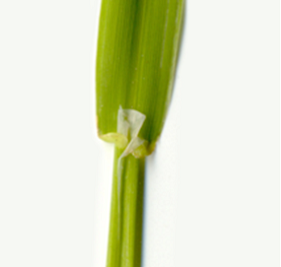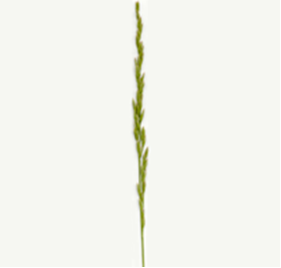Fescue toxicosis in sheep
Learn about fescue toxicosis symptoms, testing and prevention in grazing sheep.
Introduction
Fescue toxicosis is a condition occasionally found in grazing sheep. Grazing animals can get sick from eating tall fescue grass that is infected with a harmful fungus. Toxins from the fungus may cause sheep to eat less, lose weight or have heat stress or breeding issues.
Toxins can be produced by the endophytic fungus Epichloë coenophiala. Endophytic fungi are microorganisms that live within a plant without showing up as a plant disease. E. coenophiala has a beneficial or symbiotic relationship with tall fescue (Figure 1 and Figure 2): the fungus gets nutrients from the tall fescue and protects the grass from pests and drought, which makes the grass more persistent.
The certified forage seed supply in Canada has been endophyte-free for many years. However, pastures established with seed from other seed sources may be infected. For example, turfgrass fescue varieties often intentionally contain endophytes to enhance persistence in sports fields. Pastures that have grasses spreading in from nearby ditches and meadows, rather than being seeded intentionally, may also contain endophyte-positive tall fescue. When a pasture consists of tall fescue that is not endophyte-free, there is a risk of fescue toxicosis to grazing livestock.
Symptoms
Fescue toxicosis has many symptoms. Mild symptoms may go undetected in sheep, and issues may not be apparent until more severe symptoms are present. Symptoms are similar to ergotism, a condition where sheep get sick from eating grass or grain infected with a harmful ergot fungus, Claviceps purpurea. The endophyte E. coenophiala produces many of the same toxins that cause ergot disease. Misdiagnosis between fescue toxicosis and ergotism may be common.
Symptoms of fescue toxicosis in sheep may include:
- loss of body weight
- signs of heat stress
- rough hair coat or poor wool production
- fever
- excessive salivation
- rapid breathing
- low conception rate
- early abortion in pregnant animals
- poor offspring survival
- reduced milk production
- constriction of blood vessels
- lameness in one or both hind feet (fescue foot) which can potentially progress to tissue death; fescue foot is most common in fall and winter when livestock are fed endophyte-positive forage
- loss of appendages such as ears, hooves and tails
Caution:
- If sheep show symptoms of fescue toxicosis, remove them from the pasture immediately.
- Ewes and ewe lambs should not be bred while grazing endophyte-positive tall fescue.
Mycotoxin testing
Some laboratories that analyze feed and forage samples are equipped to test for toxic ergot alkaloids. Grazing animals can select what they eat from the pasture, so this test is only useful to determine the presence or absence of ergot alkaloids in the pasture sample. It is impossible to know how much of the toxins the sheep are consuming.
To collect a pasture sample:
- Sample tall fescue plants that have been growing for at least a month. Early summer is an ideal time to test.
- Download the submission form and any specific instructions from the laboratory.
- Walk in a zig-zag pattern across the field. At random points, stop and grab a handful of grass. This should include all the above-ground material, and a little bit of the roots.
- Collect a total of 20–30 grab samples.
- Seal in a plastic freezer bag and place on ice immediately after collection. Clearly label as directed by the laboratory.
- Ship the sample on ice to the laboratory using an overnight courier. Do not send samples on Friday, Saturday or Sunday to prevent delays in shipping over the weekend.
- If the sample must be stored before shipping, keep it frozen.
The mycotoxin test cannot distinguish between fescue toxicosis and ergotism, since it does not identify the fungus that produced the ergot alkaloids.
Pasture management
The most effective way to prevent a recurrence of fescue toxicosis is to terminate the existing pasture and re-establish it with endophyte-free seed. The forage seed supply of tall fescue in Canada is endophyte-free. Turf varieties (such as for lawns or sports fields) are not recommended, as they frequently contain endophytes.
Where pasture termination is not possible, there are a few practices that may reduce risk:
- Graze endophyte-positive tall fescue before seed heads develop in late spring or early summer.
- Mow pasture grass to prevent seed set, because infected seeds contain very high concentrations of ergot alkaloids.
- Avoid grazing endophyte-positive pastures during hot temperatures that stress the tall fescue.
- Increase the amount of grass left after grazing, or grazing residual, by leaving more grass behind. Because there is a higher concentration of endophytes and alkaloids in the stem than in the leaf blades, grazing close to the ground exposes sheep to more alkaloids.
- “Stockpile” tall fescue to graze in late fall and winter to reduce exposure to mycotoxins, as toxin levels are lowest during the non-growing season.
- Institute rotational grazing to make it easier to implement fescue toxicosis prevention practices.
- Keep up with proper fertilizer management to reduce stress on pasture crops. Soil test at least once every 5 years and add nutrients to keep phosphorus (P) at 12 ppm and potassium (K) at 120 ppm. Do not over-fertilize, especially with nitrogen (N), as too much N can increase alkaloid production.
- Overseed the pasture with legumes to help reduce the amount of fescue the sheep consume.
References
Arnold, M., Gaskill, C., and Smith, R. July 2014. Fescue toxicosis. University of Kentucky, College of Agriculture, Food and Environment, Cooperative Extension Service. Accessed July 29, 2024.
Burke, J.M., Jackson, W.G., and Robson, G.A. 2002. Seasonal changes in body weight and condition, and pregnancy and lambing rates of sheep on endophyte-infected tall fescue in the south-eastern United States. Small Ruminant Research. 44: 141-151.
Gelley, C. July 10, 2018. Tall Fescue Toxicosis — Knowing the Signs. Ohio State University, College of Food, Agricultural and Environmental Sciences. Accessed July 30, 2024.
Roberts, C. April 2000. Tall Fescue Toxicosis. University of Missouri Extension. Accessed July 30, 2024.
This fact sheet was written by Danica Davis, forage and grazing summer student, OMAFA, and Christine O’Reilly, forage and grazing specialist, OMAFA.

